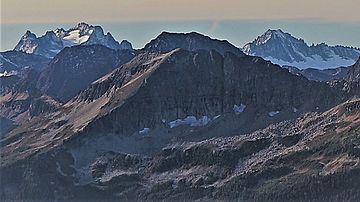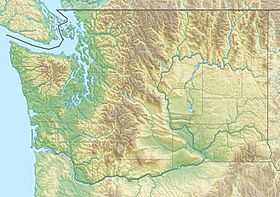Gabriel Peak (Washington) facts for kids
Quick facts for kids Gabriel Peak |
|
|---|---|

Beebe Mountain (front center), Gabriel Peak (back center), Mt. Logan (left), Mt. Buckner (right) seen from Crater Mountain.
|
|
| Highest point | |
| Elevation | 7,920 ft (2,410 m) |
| Prominence | 1,920 ft (590 m) |
| Isolation | 2.70 mi (4.35 km) |
| Parent peak | Kitling Peak (8,003 ft) |
| Geography | |
| Location | North Cascades National Park Skagit County, Washington, U.S. |
| Parent range | North Cascades Cascade Range |
| Topo map | USGS Crater Mountain |
| Climbing | |
| Easiest route | South slope |
Gabriel Peak is a tall mountain in Washington state, standing about 7,920 feet (2,414 meters) high. It's located inside North Cascades National Park in Skagit County. This peak is part of the North Cascades mountain range, which is a section of the larger Cascade Range.
Gabriel Peak is known for how steeply it rises from the land around it, even more than its exact height. It climbs about 4,700 feet (1,433 meters) from the Panther Creek valley in just about one mile. Rain and snowmelt from the peak flow into Gabriel and Panther Creeks, eventually reaching Ross Lake.
Nearby mountains include Cosho Peak (2.7 miles or 4.3 kilometers south), Beebe Mountain (2.5 miles or 4.0 kilometers north), and Red Mountain (3 miles or 4.8 kilometers southwest).
The mountain was named after the archangel Gabriel. This name connects to Tommy Rowland, who settled in the Skagit River area in 1895 and called himself "Prophet Elisha." Other nearby places like Mount Prophet, Genesis Peak, and Elija Ridge were also named because of Rowland.
Weather at Gabriel Peak
Gabriel Peak is in a region called the marine west coast climate zone. This means it gets a lot of moisture from the Pacific Ocean. Most weather systems come from the Pacific and move northeast towards the Cascade Range.
When these weather systems hit the tall North Cascades mountains, the air is forced to rise. As the air goes higher, it cools down and drops its moisture as rain or snow. This process is called Orographic lift. Because of this, the western side of the North Cascades gets a lot of rain and especially heavy snowfall in winter.
During winter, the weather is often cloudy. However, in summer, high-pressure systems over the Pacific Ocean bring clear skies and less cloud cover. The snow here tends to be wet and heavy due to the ocean's influence, which can lead to a high risk of avalanches. The best time to visit or climb Gabriel Peak is usually from July through September, when the weather is most pleasant.
How Gabriel Peak Formed
The North Cascades mountains have very rugged shapes, with sharp peaks, rocky ridges, and deep valleys carved by glaciers. The amazing landscape and big changes in elevation were created by geological events that happened millions of years ago. These changes also led to different climates and types of plants in the area.
The Cascade Range began forming millions of years ago, during the late Eocene Epoch. At that time, the North American Plate was slowly moving over the Pacific Plate. This movement caused many volcanic eruptions. Also, small pieces of the Earth's crust, called terranes, came together to form the North Cascades about 50 million years ago.
Later, during the Pleistocene period (which started over two million years ago), huge sheets of ice called glaciers moved across the land many times. As they advanced and retreated, they scraped away rock and left behind debris. The "U"-shaped valleys you see today were carved out by these glaciers. The combination of the land being pushed up (called uplift) and cracks forming in the Earth's crust (called faulting), along with the action of glaciers, created the tall peaks and deep valleys of the North Cascades.



